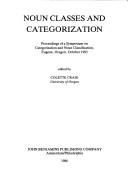| Listing 1 - 3 of 3 |
Sort by
|
Book
ISBN: 3110289334 3110287633 9783110287639 9783110289336 Year: 2013 Volume: 250 Publisher: Berlin
Abstract | Keywords | Export | Availability | Bookmark
 Loading...
Loading...Choose an application
- Reference Manager
- EndNote
- RefWorks (Direct export to RefWorks)
This book studies the syntax and semantics of numeral classifiers in Mandarin and other Chinese languages. It explores how Chinese classifiers are semantically interpreted in syntactic contexts and how semantic functions of classifiers are realized at the syntactic level. The book is a contribution to formal Chinese linguistics, and to the understanding of grammatical properties of nominal phrases in Chinese and East Asian languages.
Chinese language -- Classifiers. --- Chinese language -- Grammar. --- Chinese language -- Semantics. --- Chinese language -- Syntax. --- Classifiers (Linguistics). --- Chinese language --- Classifiers (Linguistics) --- Languages & Literatures --- East Asian Languages & Literatures --- Syntax --- Classifiers --- Semantics --- Classifiers. --- Semantics. --- Syntax. --- Chinois (Langue) --- Classificateurs (Linguistique) --- Classificateurs --- Syntaxe --- Sémantique --- Auxiliary numerals (Linguistics) --- Determinatives (Linguistics) --- Grammar, Comparative and general --- Linguistics --- Sino-Tibetan languages --- Bare Nouns. --- Chinese. --- Determiners. --- Numeral Classifiers.

ISBN: 9027228736 091502733X 9027228744 9786613313935 1283313936 9027279179 9789027279170 9780915027330 0915027348 9780915027347 Year: 1986 Volume: vol 7 Publisher: Amsterdam Philadelphia J. Benjamins
Abstract | Keywords | Export | Availability | Bookmark
 Loading...
Loading...Choose an application
- Reference Manager
- EndNote
- RefWorks (Direct export to RefWorks)
This volume is about the nature of categories in cognition and the relevance of these in language description, especially classifier systems. The classical view of categories was that they were discrete and based upon clusters of properties which were inherent to the entities. In recent years this conception has been challenged in different fields. By now prototype theory has established itself as one of the main approaches in linguistics. This volume brings classifier systems to the attention of cognitive psychologists dealing with the phenomenon of human categorization. For the general lingu
Lexicology. Semantics --- Classifiers (Linguistics) --- -Grammar, Comparative and general --- -Language acquisition --- -Semantics --- -801.56 --- 801.56 Syntaxis. Semantiek --- Syntaxis. Semantiek --- Formal semantics --- Semasiology --- Semiology (Semantics) --- Comparative linguistics --- Information theory --- Language and languages --- Lexicology --- Meaning (Psychology) --- Acquisition of language --- Developmental linguistics --- Developmental psycholinguistics --- Language development in children --- Psycholinguistics, Developmental --- Interpersonal communication in children --- Psycholinguistics --- Comparative grammar --- Grammar --- Grammar, Philosophical --- Grammar, Universal --- Philosophical grammar --- Linguistics --- Philology --- Auxiliary numerals (Linguistics) --- Determinatives (Linguistics) --- Grammar, Comparative and general --- Congresses --- Grammatical categories --- Nominals --- -Congresses --- Acquisition --- Grammar, Comparative --- Classifiers --- Language acquisition --- Semantics --- Congresses. --- 801.56 --- Grammatical categories&delete& --- Nominals&delete& --- Classificatoren [Taalwetenschap]. (Congres) --- Categorieën [Spraakkunst]. (Congres) --- Semantiek. (Congres) --- Taal. Aanleren. (Congres) --- Classificateurs [Linguistique]. (Congrès) --- Catégories [Grammaire]. (Congrès) --- Sémantique. (Congrès) --- Langage. Apprentissage. (Congrès) --- Naamwoorden. (Congres)
Book
ISSN: 1158629X ISBN: 2853996360 9782853996365 Year: 2006 Volume: 14 Publisher: Aix-en-Provence: Publications de l'Université de Provence,
Abstract | Keywords | Export | Availability | Bookmark
 Loading...
Loading...Choose an application
- Reference Manager
- EndNote
- RefWorks (Direct export to RefWorks)
C'est la classe de langue étrangère qui sert de thème fédérateur à la réflexion d'un nombre important de chercheurs et de praticiens - venus d'horizons multiples tant géographiques que scientifiques - dont les contributions sont réunies ici. L'étendue et la diversité des perspectives autour de ce même objet de réflexion ont été privilégiées pour faire de cet ouvrage un espace ouvert au dialogue, permettant à chacun des auteurs de préciser dans quelle perspective il envisage ce milieu si singulier et paradoxal. Ce travail s'articule autour de quatre chapitres : la place de la langue dans l'enseignement, des pistes théoriques, le point de vue des acteurs (motivations, attitudes et représentations) et enfin différentes questions au nombre desquelles la sociolinguistique, les discours et syntaxe, la littérature, la phonétique et le non-verbal. Après la diversité, c'est la question des corpus de la classe de langue qui est soulignée, la richesse des extraits recueillis in vivo dans les différentes classes en Italie, Angleterre, France, Belgique, Allemagne et même en Australie fournira sans doute une base de données exploitable par l'étudiant, le chercheur ou le pédagogue. Il faut former le souhait que cet ouvrage favorisera les échanges entre les auteurs connus ou moins connus qui y ont contribué mais aussi entre tous ceux qui travaillent sur la classe de langue.
Second language acquisition. --- Language and languages --- Linguistic analysis (Linguistics) --- Sociolinguistics. --- Classifiers (Linguistics) --- Categorization (Linguistics) --- Langue seconde --- Langage et langues --- Analyse linguistique (Linguistique) --- Sociolinguistique --- Classificateurs (Linguistique) --- Catégorisation (Linguistique) --- Study and teaching. --- Acquisition --- Etude et enseignement --- Second language acquisition --- Sociolinguistics --- Study and teaching --- Frans als vreemde taal --- Franse taal --- Taal en talen --- Vreemdetalenonderwijs --- didactiek --- didactiek. --- Catégorisation (Linguistique) --- Foreign language training --- Language and society --- Society and language --- Sociology of language --- Language and culture --- Linguistics --- Sociology --- Integrational linguistics (Oxford school) --- Second language learning --- Language acquisition --- Analysis, Linguistic (Linguistics) --- Analysis (Philosophy) --- Grammar, Comparative and general --- Foreign language study --- Language and education --- Language schools --- Auxiliary numerals (Linguistics) --- Determinatives (Linguistics) --- Classification (Linguistics) --- Social aspects --- Sociological aspects --- Classifiers --- Language and languages Study and teaching --- Language and languages - Study and teaching --- LANGAGE ET LANGUES --- ETUDE ET ENSEIGNEMENT --- Langues --- Étude et enseignement
| Listing 1 - 3 of 3 |
Sort by
|

 Search
Search Feedback
Feedback About UniCat
About UniCat  Help
Help News
News